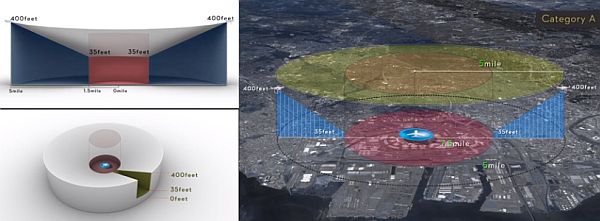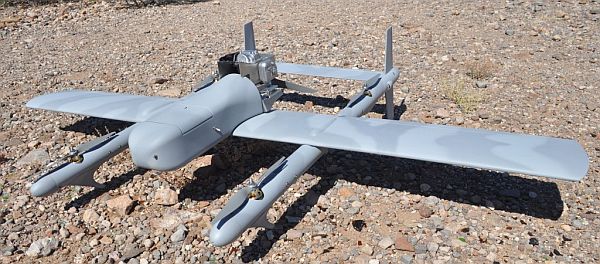Podcast: Play in new window | Download (Duration: 31:13 — 18.0MB)
Phantom firmware update addresses safety concerns, FAA files appeal brief in Trappy case, a search and rescue team fights to use quadcopters, 33 organizations appeal to the FAA, machine guns versus drones, Google beats out Facebook for atmospheric satellites, and a drone pilot is charged with a felony.
The News:
Chinese manufacturer programs Phantom drones with no-fly zones to protect Australian airports
DJI Innovations is introducing a firmware update to the Phantom 2 quadcopter “to increase flight safety and prevent accidental flights” in around 350 “No Fly Zones” world-wide. The update downloads a global GPS database of restricted locations. If the Phantom has a sufficient GPS signal, it will not fly into the restricted area.
The airport list includes Category A for large international airports with a 5 mile safety zone. In the first 1.5 mile radius, you will be unable to take off. From 1.5 miles to 5 miles from the airport, there is an increasing height limitation – 35 feet at 1.5 miles to 400 feet at 5 miles.
Category B features a 0.6 mile safety zone radius, and is intended for smaller airports. Inside that zone, you will be unable to take off.
If you approach a safety zone from outside the radius, you receive a warning. If you accidentally fly into a safety zone, and then your Phantom acquires a GPS signal the Phantom lands immediately inside the no-takeoff area, and descends to the specified maximum height in the height-restricted area.
FAA Files Appeal Brief In Closely-Watched Drone Pilot Case
The FAA has filed its appeal brief in their case against Raphael Pirker, which they lost in a ruling by an NTSB judge. Two issues are raised by the FAA in the brief:
1. The judge erred in determining that Pirker’s small drone was not an “aircraft,” as defined by the Federal Aviation Regulations (FARs).
2. The judge erred in determining that the small drone’s operation was not subject to the FARs.
Search teams that rely on drones run afoul of FAA
The Vernon Parish, Louisiana Sheriff’s Office asked Texas EquuSearch for help in finding the missing James Stephens, and they put out a call for searchers on foot and ATV.
The group has used small drones for searches since 2005, and has located the bodies of 11 missing persons. Texas EquuSearch founder Tim Miller, in referring to the FAA prohibition said, “We’ll go by some of their rules, but certainly not all of them. There is a possibility he (Stephens) could be still be alive out there, so yes we’re going to use it.”
The Academy of Model Aeronautics (AMA), the Association for Unmanned Vehicle Systems International (AUVSI), and 31 other organizations sent a letter to the FAA “encouraging the agency to expedite the rulemaking process for unmanned aircraft systems (UAS) operations in the U.S. airspace. The letter also calls on the FAA to allow the limited use of small UAS for commercial purposes before the final rulemaking is completed.”
The letter states, “The time for resolution has come, and we cannot afford any further delays. The technology is advancing faster than the regulations to govern it. While the FAA has indicated its intention to appeal the Pirker decision to the full National Transportation Safety Board, we strongly encourage the FAA to simultaneously expedite its small UAS rulemaking and issue notice and public comment as soon as possible.”
When David Cenciotti posted images in The Aviationist of a small drone believed to be used by the U.S. Army in Pakistan and Iraq, some thought these UAVs would be an easy target for small arms fire. So a group at a shooting range in Arizona thought they’d test the theory with automatic weapons. They weren’t very successful.
Google Grabs Drone Company and Google Bought a Drone Company, Which Isn’t At All Creepy, Nope
We thought solar-powered UAV-maker Titan Aerospace was getting bought by Facebook. We were wrong and it now looks like Google is picking them up.
Titan UAVs can stay aloft for 5 years, making them a good platform to deliver Internet access to remote locations. Google already has its “Project Loon” which is balloon-based. And the Titan “atmospheric satellites” might also support Google Maps.
Police: Ohio Man’s Drone Hindered Medical Chopper
A hobbyist who flew his $4,000 hexacopter over a crash scene has been charged with a felony. Authorities say he was told to stand down but did not when a medical helicopter was about to land. He’s facing a felony charge of obstructing official business, and misdemeanor charges of misconduct at an emergency and disorderly conduct.
Video of the Week: Prototype Quadrotor with Machine Gun
Mentioned:



